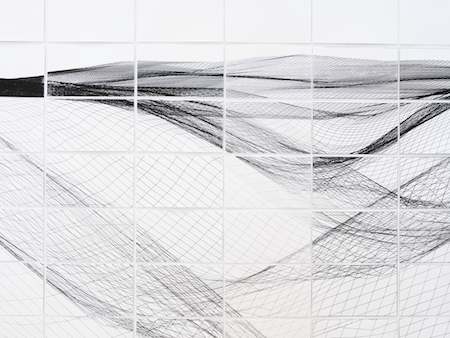
The 2025 Art Studio Senior Thesis season has been nothing short of amazing. Week after week, the senior Art Studio majors have showcased their experimental and dynamic works of art through exhibits that explore the many forms of artistic expression. These theses have left a profound impression on their attendees, with many returning each week to see more students’ evocative work.
The fourth week of thesis exhibitions was on display from Wednesday, April 16 to Sunday, April 20, 2025 in the Ezra and Cecile Zilkha Gallery. This week’s rotation featured the artwork of students Leo Heller ’25, Sydney Mai Keller ’25, Joshua Khoshayev ’25, Lev Ko ’25, Keren Mikanda ’25, Daniela Stahle ’25, Tracy Wu ’25, and Truly Zanda ’25. The Argus reached out to this week’s artists to learn more about the artistic craft behind these viscerally powerful exhibits.
“Ars Pro Omnibus, Art for All” by Joshua Khoshayev
Inspiration: “My great-great-grandfather painted Orthodox Christian icons, and I was motivated by his practice to create a body of work that would allow me to reconnect with my roots while deepening my relationship with God. In order to accurately create the icons, I went to church and met with several iconographers who taught me about their practice. They explained to me what prayers must be conducted, along with their methods of getting into the proper mindset before painting. Additionally, they explained to me the overall process of iconography.
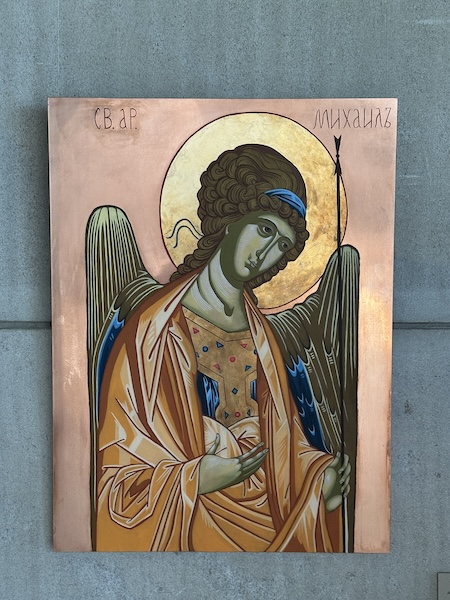
My work faithfully copies historic images of 15th-century icons, a time period chosen because it was the era that Andrei Rublev, a famous Russian iconographer, made some of history’s best known Orthodox icons. Being raised as a Russian Orthodox Christian, I often saw his work and icons inspired by his practice at church and around my household. While time has decayed my reference images, my renditions make them appear new.”
Medium: “My medium was oil paint on copper panels. I have spent several years working with oil paint and was confident that with it, I could craft images that are both luscious and luminous. Having never worked with precious metals, I used copper to experiment with a new medium. Additionally, the perception of a work created on copper [changes according] to the amount of light present in the space. The appearance of the work changes depending on the time of day, how much light is present in the room, and even the season.”

Message to Viewers: “The name of my show is ‘Ars Pro Omnibus, Art for All.’ I based the title off of the bible verse Mark 11:17, where God says, ‘My house will be called a house of prayer for all nations.’ I wanted to create a body of work that is open to anyone that is interested in it and not limited to one specific group of people.”
“1. The Grand Canyon of the Yellowstone, 2025” by Lev Ko
Inspiration: “My thesis was inspired by an interest in art history criticism surrounding westward expansion landscape paintings. In the late 19th century, large scale paintings were the premier tool of land imaging, better than photographs or illustrations, and possessed immense political utility during an age of rapid imperial expansion. Congress would send painters to accompany state-sponsored geological expeditions to record what they saw and present it before the political body in D.C. upon their return. While this program [presented painting] as an [objective] mechanism of land imaging, painting is a highly subjective medium that relies on aesthetic cues to elicit an affective response from its viewership. I chose to highlight an instance in which a painter took immense aesthetic liberty (in the way that painters do) to greatly shift the course of American imperial history.”
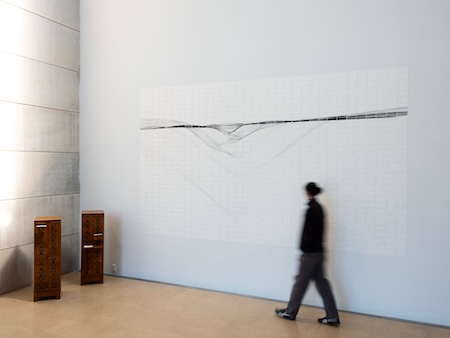
Medium: “Today, the primary tool of land imaging is no longer large-scale oil paintings. I wanted to utilize the digital materials that are analogous in a contemporary political arena to what those works of art once were during the late 19th century. Lidar, satellite imagery, and topographical data are the 21st century tools of imperial land surveillance and are ripe with their own subjectivities despite our misconceptions that they stem from a more empirical or objective place in history.”
Message to Viewers: “I don’t want to prescribe any given reaction, just hope that viewers are struck by the work and are able to see my hand in its variability. I encourage viewers looking for more context to look up Thomas Moran’s painting, from which I appropriated my title, and look into the company Maxar Technologies from which I source my topographical data.”
“Paper and Water” by Leo Heller
Inspiration: “My thesis was essentially an exercise in sustainable product design. The idea was to create a series of objects through a design process in which the aim of minimizing environmental impacts took precedence over all other considerations.”

Medium: “A simple way of putting the concept in form follows ethics. Of course, it’s easy to say that but it’s pretty tricky to implement. The relationships between consumption, design, and environmental harm are very complicated, and kind of unknowable, so I basically spent the whole first semester just thinking about all of these relationships and forming opinions about how objects might be designed to reduce their environmental impact. I developed a set of priorities that led me to choose waste paper as the material for my objects. Paper is the only material that is both biodegradable and recyclable. It’s also low-energy, light-weight, renewable, and could potentially be made from agricultural waste. I soaked the paper in water, blended it, and compressed it in molds to produce 3D forms. The particular forms of the objects were generally based on efficiency.”
Message to Viewers: “I would be happy if the work made viewers think a bit about what it means for an object to be sustainable.”
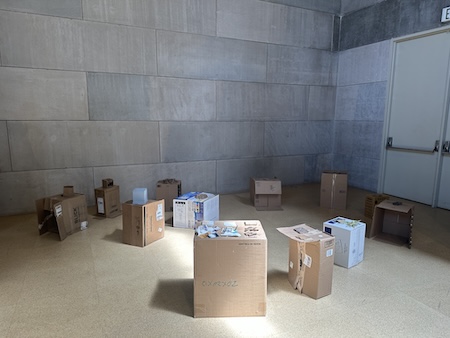
“Bearing” by Truly Zanda
Inspiration: “My work derives from mount-making practices in museums. I’m interested in how support structures that hold up art can communicate the form of an absent art object and, by extension, how support structures in everyday life—family, friends, material objects—can communicate the individual sometimes better than the individual themself. My thesis then became about outlining form and the contours of bodies, representing how forms support weight, and the reciprocal interaction between support and object.”
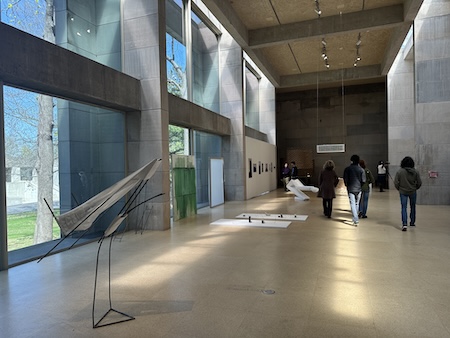
Medium: “I did a sculpture thesis, and I used a bunch of manufacturing materials such as rebar, plaster cloth, bondo/epoxy resins, insulating foam, and memory foam. I also used a found object in my thesis: an air curtain. Most of the sculptures in my thesis look industrial, even medical, which I hope conveys care.”
Message to Viewers: “I hope viewers reflect on and recognize their support structures and invisible systems that make up art and their own identities. What goes unnoticed that you always rely on? I hope viewers learn something about me as well.”
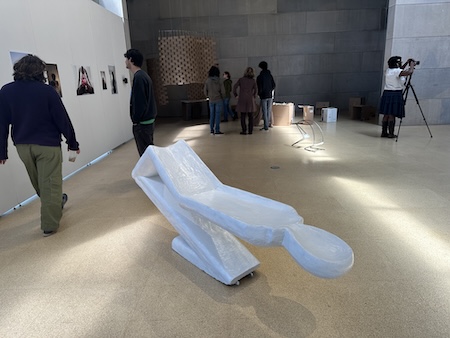
“Greenroom” by Tracy Wu
Inspiration: “My work is rooted in my passion for cinema, and what role the film medium, viewership, and cinema space play in forming intimacy and thinking of relationality. I spend a lot of time watching films in all kinds of different spaces, including a porno theater and a family roof garden.”
Medium: “I thought of myself [as] an anthropologist even before I studied anthropology at Wesleyan. The curiosity and love for people is so central to my being. There’s much stigma around spaces like the adult cinema and I want to pay attention to the value of it, e.g. the ‘impersonal intimacy’ formed there that shapes the imagination of ‘Other.’ I also want to acknowledge and reflect on the simultaneous existence of violence and care [in my temporary cinema], which also dominates in the familial settings. That’s one of the associations in the juxtaposition of the two seemingly very different spaces in my work.”
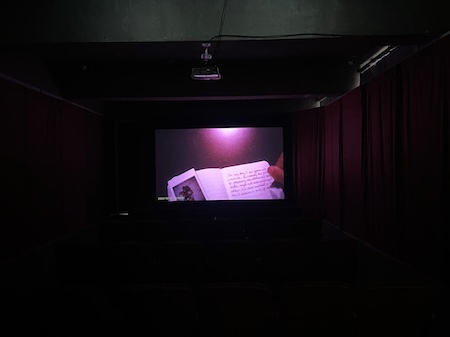
Message to Viewers: “The work draws from literary works I found inspiring by theorists and writers like Leo Bersani and Samuel Delany. Throughout the process, I always kept it in mind to make [my work] open, and I have been enjoying different attitudes and responses the work has received. The goal is more to start many conversations about this part of history, about stigma and transgression, about sexuality, about family, and sometimes about me. The desire to be understood constantly drives me to make work. I put in a lot of effort into the installation, and I’m proud of this temporary cinema I built in South Gallery. I watched a cult film there with some friends during the gallery after hours. Being a member of the film board and programming for Wesleyan Film Series is my favorite experience in the past four years. After uninstalling the thesis show, I wonder when will be the next time I build a cinema or communal watching space like this.”
The above interviews have been edited for length and clarity.
Maggie Smith can be reached at mssmith@wesleyan.edu.



Leave a Reply